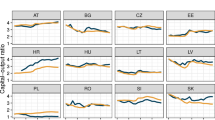Abstract
Older vintages of growth theory such as Solow (1956) Swan (1956) or Cass, (1965) assume diminishing marginal productivity of capital and predict convergence of levels in output and capital, so that they are of little use in answering questions of development. ‘Poor’ countries have a lower capital stock and thus a higher marginal productivity of capital and a higher interest rate than ‘rich’ countries. Consequently, consumers in ‘poor’ countries find it more worthwhile to save and postpone consumption than those in ‘rich’ countries and thus ‘poor’ countries grow faster than ‘rich’ countries until they have caught up. These older vintages of growth theories are of little use in explaining persistent differences in long-run growth rates, since these are simply given by the sum of the exogenous rate of population growth and the exogenous rate of labour-augmenting technical progress.
The authors are grateful to Willem Buiter, Christian Keuschnigg and Ken Kletzer for their detailed, helpful and constructive comments. The participants of seminars at CentER, Free University Amsterdam, ECOZOEK, Copenhagen University, Leuven University, and the Institute for Advanced Studies, Vienna, a CEPR meeting at the Banca d’Espana and a conference organised by the European Science Foundation, Sitges, have also made helpful comments. We also gratefully acknowledge financial support from the SPES programme Macroeconomic Policy and Monetary Integration in Europe (0016-NL (A)) of the European Community and financial support from the CEPR research programme in International Macroeconomics, supported by the Ford Foundation and the Alfred P. Sloan Foundation.
Access this chapter
Tax calculation will be finalised at checkout
Purchases are for personal use only
Preview
Unable to display preview. Download preview PDF.
Similar content being viewed by others
References
Alogoskoufis, G.S. and van der Ploeg, F. (1990) ‘Endogenous Growth and Overlapping Generations’, CEPR Discussion Paper no. 496, London.
Alogoskoufis, G.S. and van der Ploeg, F. (1991) ‘Debts, Deficits and Growth in Interdependent Economies’, CentER Discussion Paper no. 9104, Tilburg.
Arrow, K.J. (1962) ‘The Economic Implications of Learning by Doing’, Review of Economic Studies, vol. 29, pp. 155–73.
Barro, R.J. (1974) ‘Are Government Bonds Net Wealth?’, Journal of Political Economy, vol. 82, 1095–117.
Buiter, W.H. and Kletzer, K. (1991) ‘Persistent Differences in National Productivity Growth Rates with a Common Technology and Free Capital Mobility’, Journal of the Japanese and International Economies.
Cass, D. (1965) ‘Optimum Growth in an Aggregative Model of Capital Accumulation’, Review of Economic Studies, vol. 32, pp. 233–40.
Conlisk, J. (1967) ‘A Modified Neoclassical Growth Model with Endogenous Technical Change’, Southern Economic Journal, pp. 199-208.
Conlisk, J. (1969) ‘A Neoclassical Growth Model with Endogenously Positioned Technical Change Frontier’, Economic Journal, vol. 79, pp. 348–62.
Lucas, R.E. (1988) ‘On the Mechanism of Economic Development’, Journal of Monetary Economics, vol. 22, pp. 3–42.
Obstfeld, M. (1989) ‘Fiscal Deficits and Relative Prices in a Growing World Economy’, Journal of Monetary Economics, vol. 23, pp. 461–84.
Ramsey, F.P. (1928) ‘A Mathematical Theory of Savings’, Economic Journal, vol. 38, pp. 543–59.
Romer, P.M. (1986) ‘Increasing Returns and Long-run Growth’, Journal of Political Economy, vol. 94, pp. 1002–37.
Sala-i-Martin, X. (1990) ‘Lecture Notes on Economic Growth (II): Five Prototype Models of Endogenous Growth’, mimeo, Harvard University.
Solow, R.M. (1956) ‘A Contribution to the Theory of Economic Growth’, Quarterly Journal of Economics, vol. 70, pp. 65–94.
Swan, T.W. (1956) ‘Economic Growth and Capital Accumulation’, Economic Record, vol. 32, pp. 334–61.
Uzawa, H. (1965) ‘Optimum Technical Change in an Aggregative Model of Economic Growth’, International Economic Review, vol. 6, pp. 18–31.
van der Ploeg, F. (1991) ‘Money and Capital in Interdependent Economies with Overlapping Generations’, Economica, vol. 58, pp. 223–56.
Author information
Authors and Affiliations
Editor information
Editors and Affiliations
Copyright information
© 1993 International Economic Association
About this chapter
Cite this chapter
Alogoskoufis, G.S., van der Ploeg, F. (1993). Endogenous Growth, Convergence and Fiscal Policies in an Interdependent World. In: Frisch, H., Wörgötter, A. (eds) Open-Economy Macroeconomics. International Economic Association Series. Palgrave Macmillan, London. https://doi.org/10.1007/978-1-349-12884-6_15
Download citation
DOI: https://doi.org/10.1007/978-1-349-12884-6_15
Publisher Name: Palgrave Macmillan, London
Print ISBN: 978-1-349-12886-0
Online ISBN: 978-1-349-12884-6
eBook Packages: Palgrave Economics & Finance CollectionEconomics and Finance (R0)




